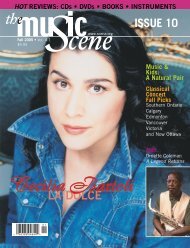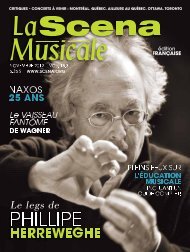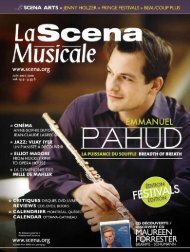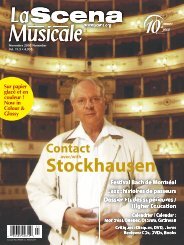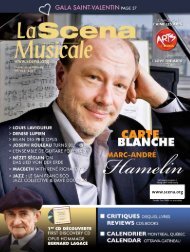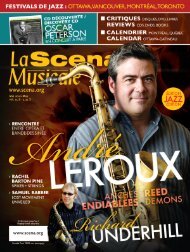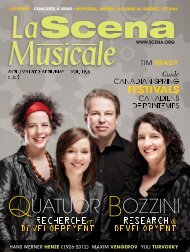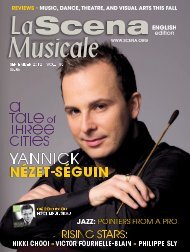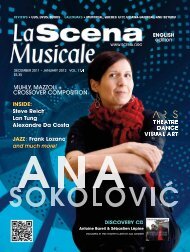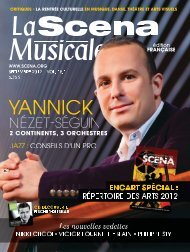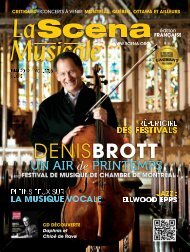You also want an ePaper? Increase the reach of your titles
YUMPU automatically turns print PDFs into web optimized ePapers that Google loves.
JEUNES en MUSIQUE<br />
Lucie Renaud<br />
Les Jeunesses <strong>Musicale</strong>s du Canada<br />
célèbrent cette saison leurs noces de<br />
diamant : 60 ans à défricher un terrain<br />
alors presque vierge, à entretenir<br />
la flamme, à poursuivre la mission<br />
franchement idéaliste que s’étaient<br />
donnée les instigateurs du mouvement.<br />
Travelling arrière sur un périple fertile en<br />
rebondissements, puis travelling avant sur les<br />
projets actuels du mouvement.<br />
DU RÊVE…<br />
Saint-Hyacinthe, 23 août 1949: date d’une<br />
rencontre-clé qui devait éventuellement sceller<br />
le destin des JMC. «Effronté et culotté» –<br />
comme il le dit lui-même dans l’autobiographie<br />
Terre des jeunes – , le violoniste Gilles<br />
Lefebvre convoque des intervenants particulièrement<br />
impliqués dans le développement<br />
musical canadien: l’abbé J. H. Lemieux, infatigable<br />
animateur des Compagnons de l’art de<br />
Saint-Hyacinthe, Anaïs Allard-Rousseau, véritable<br />
dynamo de la scène musicale à Trois-<br />
Rivières et <strong>La</strong>urette Desruisseaux-Boisvert,<br />
pilier de la région de Sherbrooke, notamment<br />
en tant que cofondatrice du Festival de<br />
l’Estrie. Il évoque son projet: regrouper les<br />
sociétés musicales existantes et les unir en un<br />
dessein commun, qui inclura des tournées de<br />
concerts, la création de nouveaux groupes<br />
d’actions, la mise sur pied d’un camp d’été, la<br />
gestion de bourses d’études et des échanges<br />
entre jeunes artistes. Malgré l’apparente démesure<br />
du plan, ce dernier est adopté. En écho au<br />
mouvement international des Jeunesses<br />
<strong>Musicale</strong>s, fondé à Bruxelles en 1945 pour<br />
«combattre les facteurs qui sont le plus souvent<br />
à l’origine des conflits internationaux, le<br />
racisme et l’intolérance, par le biais du langage<br />
universel qu’est la musique», l’Hélicon est<br />
créé. (On ne sait pas encore si la section canadienne<br />
pourra se greffer au mouvement international.)<br />
L’association se compose des clubs<br />
musicaux de Grand-Mère, Mont-<strong>La</strong>urier,<br />
Saint-Hyacinthe, Shawinigan, Sherbrooke et<br />
Trois-Rivières, et se définit clairement comme<br />
une organisation visant à «promouvoir l’étude<br />
et le goût de la bonne musique et des arts chez<br />
les jeunesses canadiennes, en leur ouvrant<br />
toutes grandes les portes de la culture. Le but<br />
de l’Hélicon est aussi d’aider nos jeunes<br />
artistes canadiens et nos jeunes talents», selon<br />
le programme de fondation du mouvement.<br />
… À LA RÉALITÉ<br />
Une première série de tournées est organisée<br />
lors de la saison 1949-1950, qui met en<br />
vedette le violoniste Noël Brunet (numéro 2<br />
du pays alors, juste derrière Arthur LeBlanc,<br />
d’abord pressenti mais ayant dû annuler pour<br />
raisons de santé) et la pianiste Suzette Pratte,<br />
la soprano Marthe Létourneau accompagnée<br />
de Géraldine <strong>La</strong>vallée et l’éblouissant Gilles<br />
Breton, jeune pianiste virtuose de 14 ans qui<br />
d’hier à<br />
JEUNESSES MUSICALES DU CANADA<br />
Lucie Renaud<br />
Jeunesses <strong>Musicale</strong>s of Canada celebrates<br />
its diamond anniversary this<br />
coming season: sixty years of hewing<br />
out a place in what was almost virgin<br />
territory at the beginning, 60 years of<br />
keeping the flame burning and pursuing the<br />
unapologetically idealistic mission of the movement’s<br />
originators. LSM takes a look back at a journey<br />
that developed its own momentum and a look<br />
forward at the organization’s current projects.<br />
FROM DREAM…<br />
In Saint-Hyacinthe, August 23, 1949, a meeting<br />
took place that proved to be crucial for the formation<br />
of the JMC. In his autobiography, Terre des<br />
jeunes, violinist Gilles Lefebvre describes himself as<br />
“brash and brazen” when he took the initiative of<br />
convening the principal figures of musical development<br />
in French Canada: Father J. H. Lemieux, the<br />
indefatigable organizer of the Compagnons de<br />
l’art of Saint-Hyacinthe, Anaïs Allard-Rousseau, veritable<br />
dynamo of the music scene in Trois-Rivières,<br />
and <strong>La</strong>urette Desruisseaux-Boisvert, musical pillar<br />
of the Sherbrooke area,<br />
notably as co-founder of the<br />
Festival de l’Estrie. Gilles outlined<br />
to them his project to<br />
merge the existing music societies<br />
into a single body, whose<br />
mission would be to organize<br />
concert tours, create new<br />
action groups, establish a summer<br />
music camp, and set up a system of scholarships<br />
and exchanges for young musicians. The<br />
plan, though seemingly overambitious at first, was<br />
adopted. Inspired by the international Jeunesses<br />
<strong>Musicale</strong>s movement, founded in Brussels in 1945<br />
to “combat the factors most often responsible for<br />
international conflicts, racism, and intolerance<br />
through the international language of music,”<br />
Hélicon was created. (At this time, it was not yet<br />
known if Canada could become part of the international<br />
movement.) The association was made<br />
up of the music clubs of Grand-Mère, Mont-<br />
<strong>La</strong>urier, Saint-Hyacinthe, Shawinigan, Sherbrooke,<br />
and Trois-Rivières. In its founding statement,<br />
Hélicon defined itself as an organization aiming to<br />
“promote the study of and the taste for good<br />
music and the arts among Canadian youth, by<br />
opening wide the doors of culture to them.”<br />
Hélicon was also to help our young Canadian<br />
artists and our young talent.<br />
… TO REALITY<br />
For the 1949-1950 season a first series of tours was<br />
organized, featuring violinist Noël Brunet (No. 2 in<br />
the country at the time, after Arthur LeBlanc, who<br />
was originally scheduled but cancelled for health<br />
reasons) and pianist Suzette Pratte, soprano Marthe<br />
Létourneau accompanied by Géraldine <strong>La</strong>vallée, and<br />
the stunning 14-year-old piano virtuoso, Gilles<br />
Breton, who caused a sensation. Gilles Lefebvre,<br />
cherishing his dream of becoming an international<br />
concert violinist,left for Paris to join his teacher,René<br />
Benedetti. He took advantage of his stay to make<br />
profitable contacts with representatives of<br />
Jeunesses <strong>Musicale</strong>s. Between his desire for personal<br />
glory and the urge to radically change the<br />
Canadian musical scene, Gilles did not hesitate long.<br />
Very early one morning (he confessed in a 1999<br />
interview that he always made his decisions<br />
between 4 and 6 a.m.),he clearly saw the task before<br />
him and couldn’t wait to return home to promul-<br />
56 Novembre 2009 November



